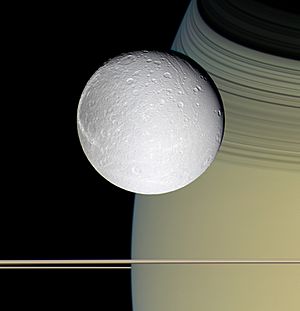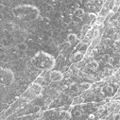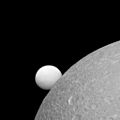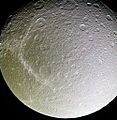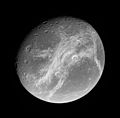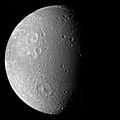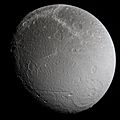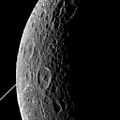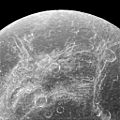Dione (moon) facts for kids
Dione is a fascinating moon that orbits the planet Saturn. It's the fourth largest moon of Saturn, measuring about 1,123 kilometers (698 miles) across. Dione was first spotted in 1684 by an astronomer named Giovanni Domenico Cassini. It's named after Dione, a powerful goddess from ancient Greek mythology. This icy moon is covered in many craters and towering ice cliffs. Dione is also "tidally locked" with Saturn, which means the same side of Dione always faces Saturn, just like our Moon always shows the same face to Earth.
Contents
Discovering Dione
Dione was one of the first moons of Saturn ever found. Giovanni Domenico Cassini, a famous Italian astronomer, discovered it in 1684. He used a telescope to observe Saturn and its surroundings, leading to this exciting find.
What Dione Looks Like
Dione is mostly made of ice and rock. Its surface is a mix of heavily cratered areas and smoother plains. This tells scientists that some parts of Dione are very old, while others might have been changed by geological activity more recently.
Craters and Cliffs
Like many moons, Dione has lots of craters. These are formed when asteroids or comets crash into its surface. Some parts of Dione also have bright, wispy streaks. These are actually networks of ice cliffs and fractures. Scientists think these cliffs might have formed when the moon's interior expanded or contracted.
The Trailing Hemisphere
One side of Dione, called the "trailing hemisphere," is especially interesting. It has a lot of bright, fractured areas. These are sometimes called "wispy terrain." This side of the moon is always facing away from the direction Dione travels in its orbit around Saturn.
Dione's Orbit
Dione orbits Saturn at a distance of about 377,400 kilometers (234,500 miles). It takes about 2.7 Earth days for Dione to complete one trip around Saturn. Because it's tidally locked, Dione spins on its axis at the same speed it orbits Saturn.
Images for kids
See also
 In Spanish: Dione (satélite) para niños
In Spanish: Dione (satélite) para niños


